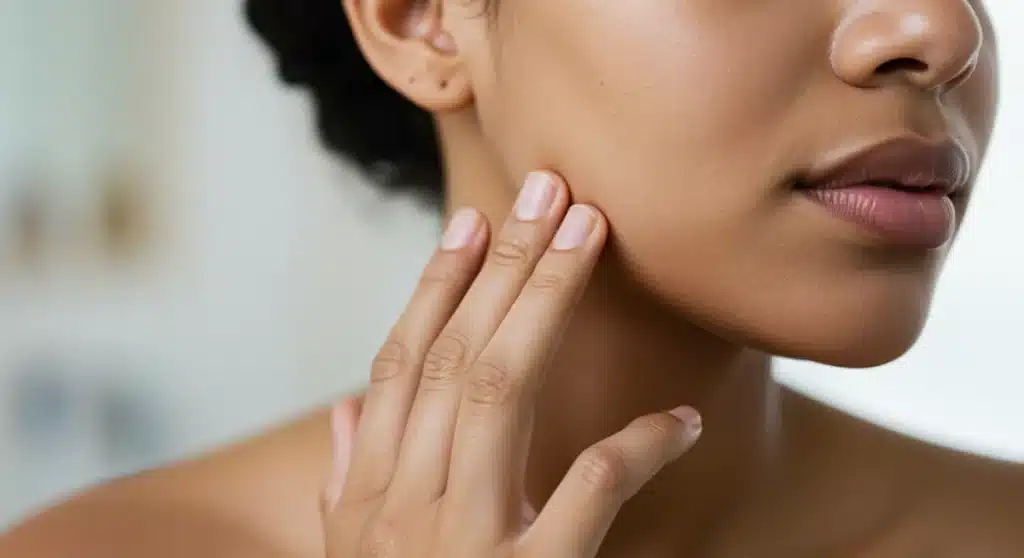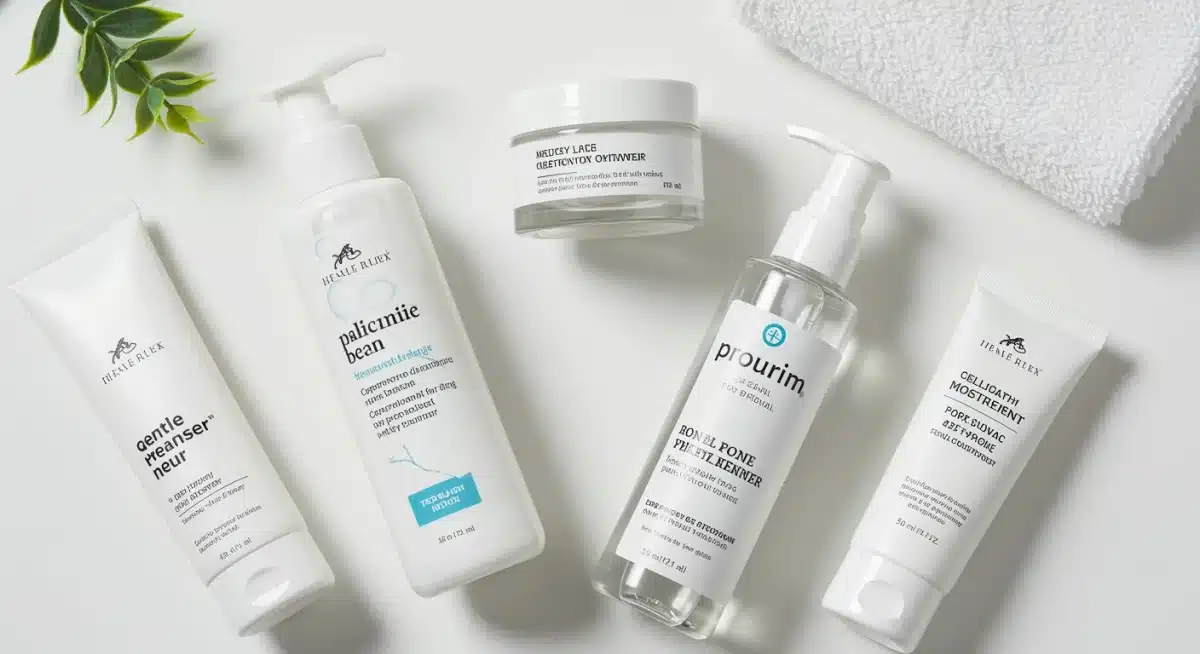Oily Skin Breakouts: 3-Month Skincare Plan for 20% Reduction

Implementing a consistent, targeted skincare routine for oily skin can significantly reduce breakouts by at least 20% within three months by controlling sebum production and addressing inflammation.
Are you tired of battling persistent breakouts and excessive oiliness? Achieving clear, balanced skin can feel like an uphill battle, but with the right approach, significant improvement is within reach. This article will guide you through Practical Solutions: A Step-by-Step Skincare Routine to Reduce Breakouts by 20% in 3 Months for Oily Skin, offering actionable advice to transform your complexion.
Understanding oily skin and breakouts
Oily skin is characterized by an overproduction of sebum, the natural oil produced by our sebaceous glands. While sebum is essential for keeping skin hydrated and protected, an excess can lead to clogged pores, inflammation, and ultimately, breakouts. Environmental factors, genetics, and hormonal fluctuations all play a role in how oily your skin becomes.
Breakouts, whether they manifest as blackheads, whiteheads, papules, or pustules, are a common concern for individuals with oily skin. Understanding the root causes of these issues is the first step towards effective management. It’s not just about what you put on your skin, but also recognizing how your skin functions.
The science behind sebum and acne
Sebum, when produced in excess, can mix with dead skin cells and bacteria (primarily Propionibacterium acnes, now known as Cutibacterium acnes) inside hair follicles. This mixture forms a plug, leading to the formation of comedones, which are the precursors to acne lesions. Inflammation then contributes to the redness and swelling associated with more severe breakouts.
- Hormonal influence: Androgens, male hormones present in both sexes, stimulate sebum production. Fluctuations during puberty, menstruation, pregnancy, or stress can trigger increased oiliness.
- Genetic predisposition: If your parents had oily or acne-prone skin, you are more likely to experience it as well.
- Environmental factors: High humidity and pollution can exacerbate oiliness and contribute to breakouts by trapping dirt and impurities on the skin.
Addressing these underlying mechanisms is crucial for developing a skincare routine that truly makes a difference. Merely drying out the skin can often be counterproductive, leading to irritation and even more oil production as the skin attempts to compensate.
Ultimately, a successful strategy for managing oily skin and reducing breakouts involves a multi-faceted approach that targets sebum regulation, exfoliation, and inflammation control. Patience and consistency are key, as skin takes time to respond to new treatments and adapt to changes in routine.
Establishing a foundational routine: weeks 1-4
The initial phase of any effective skincare routine focuses on establishing a clean slate and introducing gentle yet powerful ingredients. For oily skin prone to breakouts, this means prioritizing thorough cleansing, light exfoliation, and balanced hydration. Consistency during these first few weeks is paramount to seeing initial improvements.
Starting with a gentle approach helps your skin adapt without becoming overwhelmed or irritated. Many people make the mistake of using harsh products from the start, which can strip the skin of its natural oils and trigger a rebound effect, leading to even more oil production.
Morning routine essentials
Your morning routine should focus on preparing your skin for the day, protecting it from environmental aggressors, and controlling excess oil. It’s about setting the stage for a shine-free and breakout-resistant day.
- Gentle cleanser: Use a mild, pH-balanced cleanser to remove overnight oil and impurities without stripping your skin. Look for ingredients like salicylic acid (in low concentrations) or tea tree oil.
- Lightweight moisturizer: Even oily skin needs hydration. Opt for a non-comedogenic, oil-free moisturizer, preferably one with hyaluronic acid, to keep your skin balanced without adding greasiness.
- Broad-spectrum SPF: Sun protection is non-negotiable. Choose a non-comedogenic, matte-finish sunscreen with at least SPF 30 to prevent sun damage and post-inflammatory hyperpigmentation.
Evening routine for deep cleansing
The evening routine is your opportunity to thoroughly cleanse away the day’s grime, makeup, and pollutants, and to introduce active ingredients that work to prevent and treat breakouts while you sleep.
Begin with a double cleanse if you wear makeup or heavy sunscreen. First, use an oil-based cleanser or micellar water to break down and remove surface impurities. Follow this with your gentle water-based cleanser to thoroughly clean your pores. This two-step process ensures all traces of impurities are removed, allowing subsequent products to penetrate more effectively.
During the first month, focus on consistency. Avoid introducing too many new products at once. Allow your skin to adjust to this basic regimen before incorporating more potent treatments. This foundational period is crucial for building a healthy skin barrier and preparing your skin for more targeted interventions in the coming months.
Introducing targeted treatments: weeks 5-8
Once your skin has adjusted to the foundational routine, typically around weeks 5-8, it’s time to introduce more targeted treatments. This phase focuses on actively combating existing breakouts and preventing new ones by incorporating ingredients known for their efficacy against acne. The goal is to gently escalate your routine, not overwhelm your skin.
The key here is selective addition. Don’t add every active ingredient at once. Introduce one new product at a time and observe your skin’s reaction for a week or two before adding another. This helps you identify any potential irritants and allows your skin to gradually acclimate.
Salicylic acid for exfoliation
Salicylic acid (BHA) is a hero ingredient for oily and acne-prone skin. It’s oil-soluble, meaning it can penetrate through sebum and exfoliate inside the pore lining, effectively unclogging pores and reducing blackheads and whiteheads. It also possesses anti-inflammatory properties.
- Application: Use a salicylic acid toner or serum after cleansing in your evening routine, 2-3 times a week initially.
- Concentration: Start with a lower concentration (0.5% to 2%) to minimize irritation.
- Benefits: Helps to dissolve dead skin cells, reduce sebum, and prevent new comedones from forming.
Remember that overuse of salicylic acid can lead to dryness and irritation. Listen to your skin and adjust the frequency as needed. If you experience excessive dryness, reduce usage or consider alternating it with a hydrating product.
Benzoyl peroxide for active breakouts
Benzoyl peroxide is highly effective for treating inflammatory acne, such as papules and pustules. It works by killing acne-causing bacteria (C. acnes) and helps to shed dead skin cells from the pores. It’s a powerful tool but requires careful use.
Apply benzoyl peroxide as a spot treatment or a thin layer on affected areas in your evening routine, after your salicylic acid product (if using both). Start with a lower concentration (2.5% to 5%) and apply it every other night to begin with. Be aware that benzoyl peroxide can bleach fabrics, so use old pillowcases and towels. It can also be drying, so always follow up with a good moisturizer.

This phase is where you’ll likely start to see more noticeable changes in your skin’s texture and a reduction in active breakouts. Be patient and consistent, as results continue to build over time. If irritation occurs, scale back on active ingredients and focus on hydration until your skin recovers.
Advanced care and maintenance: weeks 9-12
By weeks 9-12, your skin should be showing significant improvement. This final phase focuses on refining your routine, maintaining the progress you’ve made, and addressing any lingering concerns. It might involve introducing additional beneficial ingredients or adjusting the frequency of your active treatments.
This is also a good time to assess what’s working best for your skin. Are certain products proving more effective than others? Is there any dryness or sensitivity you need to address? Adjustments are often necessary to keep your skin in optimal condition.
Retinoids for long-term prevention
Retinoids, such as retinol or adapalene (a prescription-strength retinoid now available over-the-counter), are excellent for long-term acne prevention and overall skin health. They work by accelerating cell turnover, preventing pores from clogging, and reducing inflammation.
- Introduction: Start with a low-strength retinol serum 1-2 times a week in your evening routine, after cleansing and before moisturizing.
- Gradual increase: Slowly increase frequency as your skin tolerates it, potentially up to every other night.
- Sun sensitivity: Retinoids can make your skin more sensitive to the sun, so consistent SPF use during the day is critical.
Expect a potential ‘purging’ phase when first introducing retinoids, where breakouts might temporarily worsen before improving. This is normal as your skin adjusts and brings underlying congestion to the surface.
Exfoliation and hydration balance
Maintaining a healthy skin barrier is crucial, even for oily skin. Over-exfoliation can compromise this barrier, leading to increased sensitivity and even more breakouts. Continue to use your salicylic acid product 2-3 times a week, or as tolerated, and ensure your moisturizer provides adequate hydration without feeling heavy.
Consider incorporating a hydrating serum with ingredients like niacinamide or ceramides. Niacinamide can help regulate oil production, reduce inflammation, and minimize the appearance of pores, while ceramides strengthen the skin barrier. These can be used daily, both morning and evening, for added benefits.
The goal of this advanced care phase is to create a sustainable routine that keeps breakouts at bay and promotes overall skin health. Remember that skincare is a journey, and your routine may need slight adjustments based on seasonal changes, stress levels, or other factors.
Lifestyle factors for clearer skin
Skincare isn’t just about what you apply topically; it’s also heavily influenced by your overall lifestyle. Integrating healthy habits into your daily routine can significantly enhance the effectiveness of your skincare products and contribute to a 20% reduction in breakouts for oily skin. These habits support your skin’s natural healing and balancing processes from within.
Neglecting lifestyle factors can undermine even the most diligent topical routine. Think of it as a holistic approach where external care and internal well-being work hand-in-hand to achieve clearer skin.
Diet and hydration
What you eat and drink directly impacts your skin. While there’s no single ‘acne diet,’ certain dietary patterns can contribute to inflammation and oil production.
- Limit high glycemic foods: Foods high in sugar and refined carbohydrates can cause blood sugar spikes, potentially leading to increased inflammation and sebum production.
- Increase omega-3 fatty acids: Found in fish, flaxseeds, and walnuts, omega-3s have anti-inflammatory properties that can benefit acne-prone skin.
- Stay hydrated: Drinking plenty of water helps maintain skin hydration and supports its natural detoxification processes. Dehydrated skin can sometimes overproduce oil to compensate.
Focus on a balanced diet rich in fruits, vegetables, and lean proteins. These provide essential vitamins and antioxidants that support skin health and repair. Avoiding processed foods and excessive dairy may also benefit some individuals.
Stress management and sleep
Stress is a known trigger for breakouts. When stressed, your body produces cortisol, a hormone that can stimulate oil glands and increase inflammation. Similarly, inadequate sleep can disrupt your body’s natural repair mechanisms, leading to duller skin and potentially more breakouts.
Prioritize stress-reducing activities such as meditation, yoga, or spending time in nature. Aim for 7-9 hours of quality sleep each night. Creating a relaxing bedtime routine can significantly improve sleep quality, allowing your skin to regenerate and heal more effectively.
By addressing these internal factors, you create an optimal environment for your skin to thrive, making your topical skincare routine even more impactful in reducing breakouts and achieving a healthier complexion.
Common pitfalls and how to avoid them
Even with the best intentions, many individuals with oily, breakout-prone skin fall into common traps that can hinder progress or even worsen their condition. Recognizing these pitfalls is crucial for successfully navigating your 3-month journey towards clearer skin and ensuring your efforts yield the desired 20% reduction in breakouts.
Avoiding these mistakes can save you time, frustration, and money, allowing your carefully constructed skincare routine to work its magic without unnecessary setbacks. It’s often about what you don’t do, as much as what you do.
Over-cleansing and harsh exfoliation
It’s tempting to think that excessively scrubbing or cleansing oily skin will remove oil and prevent breakouts. However, this often has the opposite effect.
- Stripping the skin: Harsh cleansers or over-washing can strip the skin of its natural oils, leading to a compromised skin barrier. This can trigger your skin to produce even more oil to compensate, worsening oiliness and breakouts.
- Physical scrubs: Abrasive physical exfoliants can create micro-tears in the skin, spreading bacteria and causing irritation, which can exacerbate acne. Opt for chemical exfoliants like BHAs.
Stick to gentle, pH-balanced cleansers twice a day and use chemical exfoliants as directed, rather than relying on aggressive physical methods. Your skin needs a healthy barrier to protect itself.
Product hopping and impatience
Skincare requires patience. Many people switch products too frequently, expecting instant results. It takes time for skin to respond to new ingredients, typically several weeks to see initial changes and months for significant improvement.
Introducing too many new products at once also makes it impossible to identify which ones are working or causing irritation. Introduce one new product at a time, wait at least 2-4 weeks to observe its effects, and then decide whether to continue or introduce another. Stick to your routine for the full three months to truly assess its efficacy.
Another common mistake is picking or squeezing breakouts. This can push bacteria deeper into the skin, increase inflammation, and lead to scarring or post-inflammatory hyperpigmentation. Resist the urge and let your targeted treatments do the work.
Maintaining results and long-term clarity
After successfully reducing breakouts by 20% over three months, the journey doesn’t end. The final and perhaps most crucial step is maintaining these results and ensuring long-term skin clarity. This involves consistent adherence to your refined routine, ongoing self-assessment, and proactive adjustments to keep your oily skin balanced and breakout-free.
Think of your skincare routine as a continuous process, not a temporary fix. Your skin’s needs can evolve due to age, environment, or lifestyle changes, so being adaptable is key to sustained success.
Consistency is key
The biggest factor in maintaining clear skin is consistency. Skipping steps or becoming lax with your routine can quickly lead to a return of oiliness and breakouts. Continue with your established morning and evening routine, using your gentle cleanser, targeted treatments (like salicylic acid, benzoyl peroxide, or retinoids), moisturizer, and SPF daily.
Even on days when your skin looks great, stick to the routine. Prevention is always easier than treatment. Establishing these habits makes them second nature, ensuring your skin receives the continuous care it needs.
Seasonal adjustments and product rotation
Your skin’s needs can change with the seasons. In humid summer months, you might need lighter moisturizers or more frequent use of oil-controlling products. In drier winter months, you might need to incorporate more hydrating serums or a richer, yet still non-comedogenic, moisturizer.
Similarly, it can be beneficial to rotate active ingredients. For example, if you’ve been using salicylic acid consistently, you might alternate it with a gentle AHA (alpha hydroxy acid) for different exfoliating benefits, or adjust the frequency of retinoid use. This prevents your skin from becoming accustomed to one ingredient and ensures it remains responsive.
Regularly assess your skin’s condition. Are you experiencing increased oiliness, dryness, or a new breakout? These are signals that your routine might need a slight tweak. Don’t be afraid to consult with a dermatologist or skincare professional if you encounter persistent issues or want to explore stronger prescription options for long-term management.
| Key Step | Brief Description |
|---|---|
| Weeks 1-4: Foundation | Establish gentle cleansing, hydrating, and SPF routines to prepare skin. |
| Weeks 5-8: Targeted Treatments | Introduce salicylic acid and benzoyl peroxide to actively combat breakouts. |
| Weeks 9-12: Advanced Care | Incorporate retinoids for long-term prevention and refine product usage. |
| Long-Term Maintenance | Maintain consistency, adjust seasonally, and support with healthy lifestyle choices. |
Frequently asked questions about oily skin and breakouts
While some initial improvements might be visible within a few weeks, significant reduction in breakouts, specifically the 20% target, typically takes about three months of consistent application. Skin cell turnover and healing require time, so patience is crucial for lasting results.
Yes, you can use makeup. Opt for non-comedogenic, oil-free formulas to avoid clogging pores. Ensure you thoroughly remove all makeup with a double cleanse every evening to allow your skin to breathe and absorb treatment products effectively, preventing new breakouts.
Dryness or irritation can occur when introducing active ingredients. Reduce the frequency of active treatments (e.g., use every other day instead of daily) and focus on gentle cleansing and a good, hydrating moisturizer. If irritation persists, consult a dermatologist for personalized advice.
Avoid harsh alcohols, strong fragrances, and heavy, occlusive oils that can clog pores or strip the skin. Always check product labels for terms like ‘non-comedogenic’ and ‘oil-free.’ Ingredients like synthetic dyes can also sometimes trigger sensitivity in acne-prone individuals.
For sensitive oily skin, introduce new products even more slowly. Opt for lower concentrations of active ingredients and patch test new products. Prioritize gentle, fragrance-free formulas and always listen to your skin’s reactions, scaling back if any discomfort arises. Consulting a dermatologist is highly recommended.
Conclusion
Embarking on a journey to reduce breakouts on oily skin requires commitment, understanding, and the right strategy. By following this step-by-step skincare routine, focusing on consistent cleansing, targeted treatments, and essential lifestyle adjustments, you can realistically achieve a significant reduction in breakouts within three months. Remember that every skin type is unique, and while this guide provides a robust framework, listening to your skin and making minor adjustments along the way will be crucial for long-term success and maintaining a clear, healthy complexion. Your dedication will undoubtedly pave the way for more confident and radiant skin.





